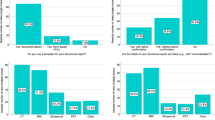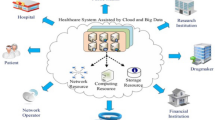Abstract
Collection of radiation dose derived from radiological examination is necessary not only for radiation protection, but also for fulfillment of structured reports. However, the material regarding of radiation dose cannot be directly utilized by the Radiological Information System (RIS) since it is generated and only stored in the Picture Archiving and Communication System (PACS). In this paper, an integration reporting module is proposed to facilitate handling of dose information and structured reporting by providing two functionalities. First, a gateway is established to automatically collect the related information from PACS for further analyzing and monitoring the accumulated radiation. Second, the designated structured reporting patterns with corresponding radiation dose measurements can be acquired by radiologists as necessary. In the design, the radiation dose collection gateway and the well-established pattern are collocated to achieve that there is no need to do manual entry for structured reporting, thus increasing productivity and medical quality.




Similar content being viewed by others
References
Kahn, C. E., Langlotz, C. P., and Burnside, E. S., Toward best practices in radiology reporting. Radiology 252(3):852–856, 2009.
Plumb, A. A. O., Grieve, F. M., and Khan, S. H., Survey of hospital clinicians’ preferences regarding the format of radiology reports. Clin. Radiol. 64(4):386–394, 2009.
World Health Organization. Health risk assessment from the nuclear accident after the 2011 Great East Japan earthquake and tsunami. Available from: http://apps.who.int/iris/bitstream/10665/78218/1/9789241505130_eng.pdf. (accessed 29 May 2016), 2013.
The ICRP, Recommendations of the international commission on radiological protection (users edition). ICRP publication 103. Ann ICRP 37(Issue 2–4):1–332, 2007.
American College of Radiology, Radiology information systems and electronic medical records, Available from: http://www.acr.org/~/media/ACR/Documents/PDF/Advocacy/IT%20Reference%20Guide/IT%20Ref%20Guide%20RISEMR.pdf. (accessed 29 May 2016).
Hussein, R., Engelmann, U., Schroeter, A., and Meinzer, H. P., DICOM structured reporting: Part 2. Problems and challenges in implementation for PACS workstations. Radiographics 24(Issue 3):897–909, 2004.
Stabin, M. G., MIRDOSE: Personal computer software for internal dose assessment in nuclear medicine. J. Nucl. Med. 37:538–546, 1996.
Stabin, M. G., Sparks, R. B., and Crowe, E., EOLINDA/EXM: The second-generation personal computer software for internal dose assessment in nuclear medicine. J. Nucl. Med. 46:1023–1027, 2005.
Chang, C. H., Chang, Y. J., Lee, T. W., Ting, G., and Chang, K. P., Dosimetric evaluation of nanotargeted (188)Re-liposome with the MIRDOSE3 and OLINDA/EXM programs. Ann. Nucl. Med. 26(5):419–425, 2012.
Stabin, M. G., Siegel, J., Hunt, J., Sparks, R., Lipsztein, J., and Eckerman, K., RADAR: The radiation dose assessment resource—an online source of dose information for nuclear medicine and occupational radiation safety. J. Nucl. Med. 42:S243, 2001.
Perales, J. L. G., and Mendoza, A. G., Freeware for reporting radiation dosimetry following the administration of radiopharmaceuticals. Appl. Radiat. Isot. 103:131–134, 2015.
Digital Imaging and Communications in Medicine (DICOM) - Supplement 23: Structured Reporting Storage SOP Classes, Available from: http://dicom.nema.org/dicom/supps/sup23_lb.pdf. (accessed 29 May 2016).
Torres, J. S., Segrelles Quilis, J. D., Blanquer Espert, I., and García, V. H., Improving knowledge management through the support of image examination and data annotation using DICOM structured reporting. J. Biomed. Inform. 45(Issue 6):1066–1074, 2012.
RadLex. Available from: http://www.radlex.org. (accessed 29 May 2016).
Langlotz, C. P., Automatic structuring of radiology reports: harbinger of a second information revolution in radiology. Radiology 224(Issue 5), 2002.
Bosmans, J. M. L., Neri, E., Ratib, O., and Kahn, C. E., Structured reporting: A fusion reactor hungry for fuel. Insights Imaging 6:129–132, 2015.
ACR-NEMA, Digital Imaging and Communications in Medicine, Supplement 10, Basic Worklist Manamgent (Basic Worklist Management), Available from: ftp://medical.nema.org/medical/dicom/final/sup10_ft.pdf. (accessed 29 May 2016).
Digital Imaging and Communications in Medicine, DICOM, Available from: http://dicom.nema.org/standard.html. (accessed 29 May 2016).
Horii, S. C., and Bidgood, W. D., DICOM: A standard for medical imaging. Proc. SPIE 1785:87–102, 1992.
Noumeir, R., DICOM structured report document type definition. IEEE Trans. Inf. Technol. Biomed. 7(4):318–328, 2003.
Author information
Authors and Affiliations
Corresponding author
Additional information
This article is part of the Topical Collection on Systems-Level Quality Improvement
Rights and permissions
About this article
Cite this article
Lee, MC., Chuang, KS., Hsu, TC. et al. Enhancement of Structured Reporting – an Integration Reporting Module with Radiation Dose Collection Supporting. J Med Syst 40, 250 (2016). https://doi.org/10.1007/s10916-016-0618-y
Received:
Accepted:
Published:
DOI: https://doi.org/10.1007/s10916-016-0618-y




